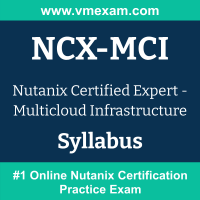 The Nutanix NCX-MCI exam preparation guide is designed to provide candidates with necessary information about the Multicloud Infrastructure exam. It includes exam summary, sample questions, practice test, objectives and ways to interpret the exam objectives to enable candidates to assess the types of questions-answers that may be asked during the Nutanix Certified Expert - Multicloud Infrastructure (NCX-MCI) exam.
The Nutanix NCX-MCI exam preparation guide is designed to provide candidates with necessary information about the Multicloud Infrastructure exam. It includes exam summary, sample questions, practice test, objectives and ways to interpret the exam objectives to enable candidates to assess the types of questions-answers that may be asked during the Nutanix Certified Expert - Multicloud Infrastructure (NCX-MCI) exam.
It is recommended for all the candidates to refer the NCX-MCI objectives and sample questions provided in this preparation guide. The Nutanix Multicloud Infrastructure certification is mainly targeted to the candidates who want to build their career in Expert Level domain and demonstrate their expertise. We suggest you to use practice exam listed in this cert guide to get used to with exam environment and identify the knowledge areas where you need more work prior to taking the actual Nutanix Certified Expert - Multicloud Infrastructure exam.
Nutanix NCX-MCI Exam Summary:
Nutanix Multicloud Infrastructure Syllabus:
|
Section |
Objectives |
|
Customer Consultation |
- Requirements
-
Gatherspecific, measurable, traceable, and concise business, technical, functional, and non-functional requirements from the customer
- Risks
-
Identify risks to solution success; and create a high-level impact analysis and/or risk mitigation plan
- Constraints
-
Identify constraints that influence the solution and create a high-level impact analysis
- Assumptions
-
Identify assumptions that influence the solution and create a high-level impact analysis
- Operational Readiness
-
Completeahigh-level organizational readiness assessment and make recommendations for training or organizational changes as required
- Migration&Transition
-
Formulatealow-risk migration strategy and discuss a roll-back strategy
|
|
Conceptual/Logical Design |
- Scalability
-
Identify and explain options for scaling Nutanix solution including application layer. Demonstrate an understanding of relationships between scalability, performance, and resilience
- Resiliency
-
Identify failure scenarios and domains and provide traceability to SLAs limited to infrastructure (SLAs, RTO, RPO)
- Performance
-
Show how customer requirements have been met and demonstrate an understanding of performance/validation tools such as FIO, IOMeter, JetStress.
-
De-scribe what can be tuned in the platform and when/when not to change default settings.
- Manageability & Control Plane Architecture
-
Explain of how management components interact and minimize complexity.
-
Describe the “business as usual” activities such as patching, upgrades, and configuration management
- Data Protection & Recoverability
-
Explain how the solution’s data protection and recoverability was designed and validated at a high-level and how RPO/RTO requirements are met
- Logical Sizing and Capacity Planning
-
Defend and validate that the design meets capacity requirements
- Compliance & Security
-
Explain how compliance, security, and risk requirements were met; Identify and provide understanding of where industry-standard security and compliance frameworks such as PCI DSS, STIG, HIPAA, EUGDPR, ISO 27001 apply
- Virtual Machine Logical Design
-
Provide explanation of virtual machine logical specifications, interoperability, and configuration
- Third Party Product Integration
-
Provide explanation of how third-party integrations provide costeffective solutions that meet customer requirements
|
|
Physical Design |
- Hardware Sizing
-
Justify sizing rationale based on calculations and demonstrate how the application working set size was obtained
- Storage Infrastructure
-
Explain impact and implications of protocols, IO sizes and patterns, and data transforms; Explain combined storage infrastructure design decisions
- Platform Selection
-
Justify selection of components in a node and cluster configuration
- Networking Infrastructure
-
Identify configuration options and explain how the chosen network topology meets customer requirements
- Virtual Machine Physical Design
-
Identify necessary physical virtual machine components such as type of scsi adaptor and system network adaptor configuration
- Management Component Design
-
Provide explanation and justification of management component configuration (e.g., patching, monitoring, updating, upgrading, sizing) such as automated patching, RHN satellite, spacewalk, PRISM Central, and Acropolis
- Data Center Infrastructure - Environmental & Power
-
Provide specifications for space, power usage, heat output and show how the solution conforms to the resources available in the chosen location(s)
|
 The Nutanix NCX-MCI exam preparation guide is designed to provide candidates with necessary information about the Multicloud Infrastructure exam. It includes exam summary, sample questions, practice test, objectives and ways to interpret the exam objectives to enable candidates to assess the types of questions-answers that may be asked during the Nutanix Certified Expert - Multicloud Infrastructure (NCX-MCI) exam.
The Nutanix NCX-MCI exam preparation guide is designed to provide candidates with necessary information about the Multicloud Infrastructure exam. It includes exam summary, sample questions, practice test, objectives and ways to interpret the exam objectives to enable candidates to assess the types of questions-answers that may be asked during the Nutanix Certified Expert - Multicloud Infrastructure (NCX-MCI) exam.